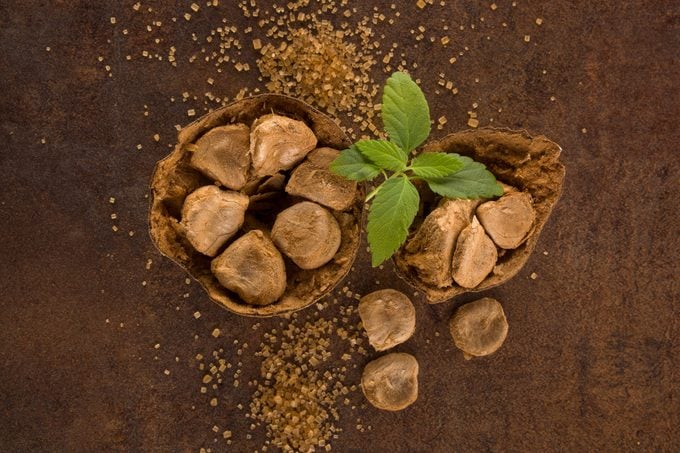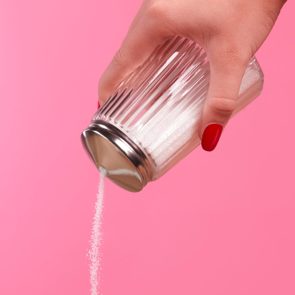What Is Monk Fruit? Get the Facts on This Zero-Calorie Sweetener
Updated: Mar. 23, 2021
Monk fruit is a zero-calorie sweetener that can be a healthier alternative to sugar and other substitutes. Here's what you need to know.
Our editors and experts handpick every product we feature. We may earn a commission from your purchases.
Zero-calorie sweeteners
When you still want sweetness but not the calories and health concerns that come with loads of sugar, you might turn to zero- or low-calorie sugar substitutes.
The U.S. Food and Drug Administration (FDA) has approved several sugar substitutes as food additives, like stevia, a plant-based sweetener. There’s a lesser-known FDA-approved sugar alternative you may have not heard of, called monk fruit.
Monk fruit is a small, round melon-like fruit from the Siraitia grosvenorii Swingle plant that is also known as luo han guo, Swingle fruit, or “Buddha fruit.” Grown in Southeast Asia, monk fruit has been used for centuries in Chinese medicine. Since its FDA approval in 2010 as a high-intensity sweetener, it’s become easier to find.
Monk fruit contains natural sugars, primarily fructose and glucose. Unlike other fruits, though, these natural sugars aren’t the reason for its sweet flavor. The sweetness actually comes from antioxidants called mogrosides.
What is monk fruit sweetener?
Monk fruit sweetener, or extract, is made by removing the skin and seeds from the fruit, then crushing the fruit to collect the juice. The juice is then dried into a concentrated powder.
This extract can be used to sweeten other foods and beverages. During processing to create monk fruit extract or sweetener, the mogrosides are separated from the fresh juice, leaving the sweetener free of fructose and glucose. (This is how sugar could be making you sick.)
Because it’s many times sweeter than sugar, small amounts of monk fruit extract are needed to sweeten a food—so small that it doesn’t add any calories.
What does monk fruit taste like?
The World Health Organization (WHO) recommends restricting consumption of sugars to no more than 10 percent of daily caloric intake, with a proposal to lower this level to 5 percent or less for optimal health, says Gabrielle Tafur, RD, a registered dietitian from Orlando.
“Substituting sugar with the currently available artificial sweeteners does not appear to have favorable clinical effects,” Tafur says, which means that a natural option like monk fruit could be a better choice, although more research is necessary to see if that’s the case.
Monk fruit is sweeter than sugar, so you know you won’t be sacrificing flavor. Some manufacturers mix monk fruit sweetener with other natural products, such as inulin (a type of plant fiber) or erythritol (a sugar alcohol) in an effort to minimize the sweetness.
But like other no-calorie sweeteners, the taste of monk fruit doesn’t appeal to everyone. It has a bit of an aftertaste, although it is less bitter than many sweetener alternatives, says Erin Palinski-Wade, RD, a registered dietitian from Hamburg, New Jersey.

Is monk fruit healthy?
The main appeal of monk fruit is that you can sweeten food with fewer health concerns.
“What’s great about monk fruit is it is about 150 to 250 times sweeter than sugar with no calories or carbohydrates, which means it has no impact on blood glucose level,” Palinski-Wade says. (This is how to maintain healthy blood sugar levels.)
Additionally, according to a study in Journal of Agricultural and Food Chemistry, monk fruit is also thought to offer anti-inflammatory benefits, which could potentially play a role in preventing cancer and diabetes.
However, more research is needed to determine what amount of monk fruit you would need to consume to potentially reap these benefits.
Since it is derived from dried fruit, monk fruit is also a more natural sweetener and has not been found to have a negative impact on the gastrointestinal system like some artificial sweeteners and sugar alcohols. (Sugar alcohols can cause diarrhea if you consume too much.)
Is monk fruit safe?
Monk fruit extract appears to be a safe sweetener choice, though it is a newer sweetener option and has not been researched extensively with regard to adverse effects, Palinski-Wade says.
In fact, a 2019 study by the European Food Safety Authority Journal‘s Panel on Food Additives and Flavourings shows that toxicity data on monk fruit extract isn’t substantial enough to make a determination on its safety as a food additive, Tafur added.
“Since monk fruit belongs to the same family of fruit as pumpkin, melon, squash, and cucumbers, anyone allergic to these fruits may potentially be allergic to monk fruit as well,” Palinski-Wade says.
However, keep in mind that monk fruit contains mogrosides, which can increase insulin secretion. This may not helpful for those whose pancreas already produces too much insulin.
Monk fruit sweetener and weight loss
There is currently not enough scientific data to determine whether monk fruit can help weight loss.
For example, a 2017 study in the International Journal of Obesity that examined 30 healthy men showed that consuming beverages containing sucrose (including monk fruit) caused some of the participants’ blood sugar levels to spike, leading them to eat more at later meals. (Note that the spike was only during the first hour after the meal.)
However, other studies, such as one published in the American Journal of Clinical Nutrition, suggest that low-calorie sweeteners have some effects on weight loss when they’re replacing regular-calorie sweeteners. In turn, this can lower your overall caloric intake and be a tool to improve weight loss maintenance.
A 2014 study in the journal Nutrients showed that people who consumed low-calorie sweeteners and drinks also often consumed less additional fat, sugar, and alcohol, among other caloric foods, in addition to exercising more. Given the evidence that low-calorie sweeteners may help with weight loss, it may be probable that monk fruit, which has zero calories, could also help.
How to eat and use monk fruit
Monk fruit extract is generally found in powdered or granule form, in packets similar to stevia and table sugar, Tafur says.
“I would recommend consuming in this form due to the fact that there are various manufacturers producing it, which can eventually result in an increase in product demand and further research,” she says.
Monk fruit extract is heat-stable, so it can be used in baked goods, as well as to sweeten beverages like coffee or tea, or in sauces and salad dressings.
Where to buy monk fruit
Monk fruit isn’t always easy to find because it’s difficult to grow and expensive to import. Therefore, it has a higher price tag in comparison to its counterparts such as Splenda or stevia, Tafur says.
Although it’s growing in popularity, it may be a while before you see it at your local grocery store or supermarket at an inexpensive price. (Although you can buy monk fruit sweetener on Amazon.)
“Until consumers feel confident in monk fruit’s ability to aid in weight management or blood glucose control, I would expect it to say at this price point,” Tafur says.





















